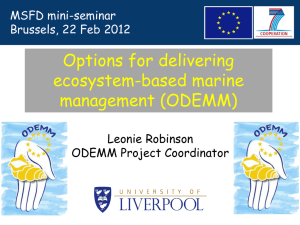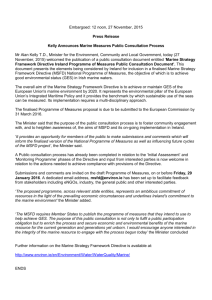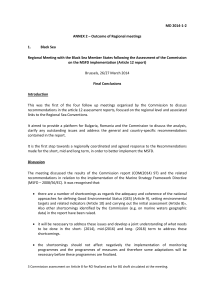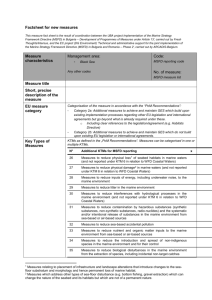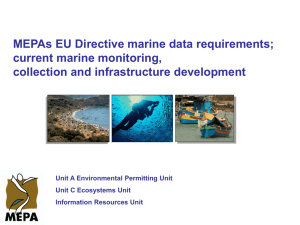BLKBG_D014_WaterColumnHabitats_FIN_EN
advertisement
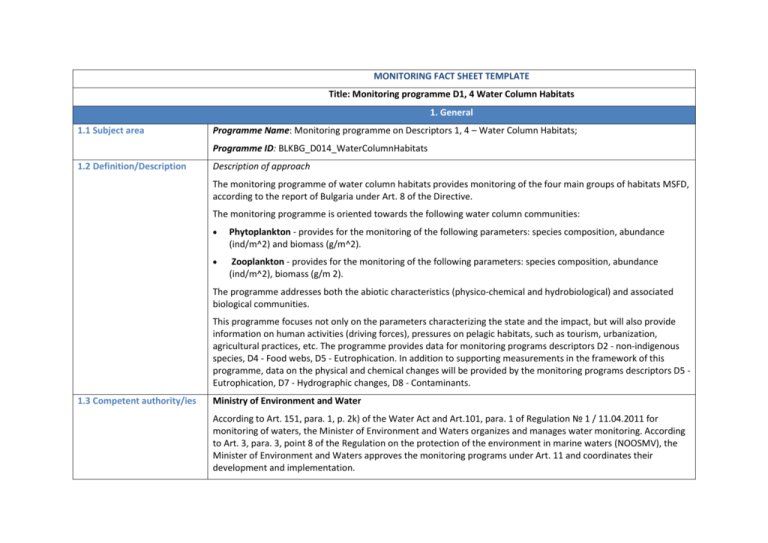
MONITORING FACT SHEET TEMPLATE Title: Monitoring programme D1, 4 Water Column Habitats 1. General 1.1 Subject area Programme Name: Monitoring programme on Descriptors 1, 4 – Water Column Habitats; Programme ID: BLKBG_D014_WaterColumnHabitats 1.2 Definition/Description Description of approach The monitoring programme of water column habitats provides monitoring of the four main groups of habitats MSFD, according to the report of Bulgaria under Art. 8 of the Directive. The monitoring programme is oriented towards the following water column communities: Phytoplankton - provides for the monitoring of the following parameters: species composition, abundance (ind/m^2) and biomass (g/m^2). Zooplankton - provides for the monitoring of the following parameters: species composition, abundance (ind/m^2), biomass (g/m 2). The programme addresses both the abiotic characteristics (physico-chemical and hydrobiological) and associated biological communities. This programme focuses not only on the parameters characterizing the state and the impact, but will also provide information on human activities (driving forces), pressures on pelagic habitats, such as tourism, urbanization, agricultural practices, etc. The programme provides data for monitoring programs descriptors D2 - non-indigenous species, D4 - Food webs, D5 - Eutrophication. In addition to supporting measurements in the framework of this programme, data on the physical and chemical changes will be provided by the monitoring programs descriptors D5 Eutrophication, D7 - Hydrographic changes, D8 - Contaminants. 1.3 Competent authority/ies Ministry of Environment and Water According to Art. 151, para. 1, p. 2k) of the Water Act and Art.101, para. 1 of Regulation № 1 / 11.04.2011 for monitoring of waters, the Minister of Environment and Waters organizes and manages water monitoring. According to Art. 3, para. 3, point 8 of the Regulation on the protection of the environment in marine waters (NOOSMV), the Minister of Environment and Waters approves the monitoring programs under Art. 11 and coordinates their development and implementation. URL: http://www.moew.government.bg/ Black Sea Basin Directorate According to Art. 155, paragraph 4b) of the Water Act and Art. 107, para. 1 of Regulation № 1 / 11.04.2011 for monitoring of waters, the Director of the BSBD - Varna plans and participates in the implementation of water monitoring, summarizes and analyses data, including that for the chemical and ecological status of water. According to Art. 3, para. 4, point 4 of the Regulation on the protection of the environment in marine waters (NOOSMV), the Director of the Black sea basin Directorate plans, develops and coordinates the monitoring programs under Art. 11. URL: http://www.bsbd.org/ 1.4 Monitoring institutions Which institutions conducted monitoring (links to a web page) Institute of Oceanology - Bulgarian Academy of Sciences Its responsibilities are defined in Art. 171, para. 2, point 3 of the Water Act and Art. 3, paragraph 11 of the Regulation on the protection of the environment in marine waters, approved by Decree № 273 from 23.11.2010, Prom. SG № 94 dated 30.11.2010, effective from 30.11.2010. URL: http://www.io-bas.bg/ 1.5 Additional information Where to find further information (e.g. web link) Black Sea Commission - Black Sea Integrated Monitoring and Assessment Programme (BSIMAP) URL: http://www.blacksea-commission.org/_bsimap.asp MSFD Guiding Improvements in the Black Sea Integrated Monitoring System (MISIS) project URL: http://www.misisproject.eu Integrated Regional monitoring Implementation Strategy in the South European Seas (IRIS -SES) project URL: http://iris-ses.eu/ Technical and administrative support for joint implementation of MSFD in Bulgaria and Romania URL: http://www.msfdblacksea.eu/ Towards Integrated Marine Research Strategy and Programmes (SEAS-ERA) project - Strategic Research Agenda for the Black Sea Basin URL: http://www.seas-era.eu/ 2. Monitoring requirements and purpose 2.1 Necessity Listed below are direct references to the monitoring requirements – EU directives, Black Sea Commission agreements, national plans, research programme requirements, other. Marine Strategy Framework Directive (MSFD) Article 11 Monitoring programmes Article 11 Annex III 1. On the basis of the initial assessment made pursuant to Article 8(1), Member States shall establish and implement coordinated monitoring programmes for the ongoing assessment of the environmental status of their marine waters on the basis of the indicative lists of elements set out in Annex III and the list set out in Annex V, and by reference to the environmental targets established pursuant to Article 10. Monitoring programmes shall be compatible within marine regions or subregions and shall build upon, and be compatible with, relevant provisions for assessment and monitoring laid down by Community legislation, including the Habitats and Birds Directives, or under international agreements. 2. Member States sharing a marine region or subregion shall draw up monitoring programmes in accordance with paragraph 1 and shall, in the interest of coherence and coordination, endeavour to ensure that: (a) monitoring methods are consistent across the marine region or subregion so as to facilitate comparability of monitoring results; (b) relevant transboundary impacts and transboundary features are taken into account. Annex III, table 1 Habitat types The predominant seabed and water column habitat type(s) with a description of the characteristic physical and chemical features, such as depth, water temperature regime, currents and other water movements, salinity, structure and substrata composition of the seabed, Annex III, table 2 Biological characteristics A description of the biological communities associated with the predominant seabed and water column habitats. This would include information on the phytoplankton and zooplankton communities, including the species and seasonal and geographical variability, Habitats Directive (Directive Art. 11 Member States shall undertake surveillance of the conservation status of the natural habitats and species 92/43/ EEC) referred to in Article 2 with particular regard to priority natural habitat types and priority species. Art. 11 Water Framework Directive (Directive 2000/60/EC) Art. 8 Water Framework Directive (Directive 2000/60 / EC) Art. 8 (1) Member States shall ensure the establishment of programmes for the monitoring of water status in order to establish a coherent and comprehensive overview of water status within each river basin district – for protected areas the above programmes shall be supplemented by those specifications contained in Community legislation under which the individual protected areas have been established Monitoring should be in accordance with the requirements of Annex V. Biological elements: Biological quality elements that must be included in the monitoring programme are set out in Annex V. Annex V 1.1 Quality elements for classification of ecological status in coastal waters: 1.1.4. Coastal waters Biological elements Composition, abundance and biomass of phytoplankton http://www.blackseaComments commission.org/_conventionConvention for the Protection of the Black Sea Against Pollution fulltext.asp Strategic Action Plan for the Black Sea (2009) Strategic Action Plan for the Art. XV (1) The Contracting Parties shall cooperate in conducting scientific research aimed at protecting and Black Sea in 2009 preserving the marine environment of the Black Sea, and where appropriate, joint research programs, and exchange Black Sea Integrated relevant scientific data and information. Monitoring and Assessment URL: http://www.blacksea-commission.org/_bssap2009.asp Programme, BSIMAP Protocol for the Protection of the Black Sea against pollution from land - based sources and activities (2009) Article 11. Information and Data Collection, Monitoring and Assessment 1. Within the framework of the provisions of, and the monitoring programmes provided for in Article XV of the Convention, and if necessary in cooperation with competent international organisations, the Contracting Parties shall: a) Collect information and data on the conditions of the marine environment and coastal areas of the Black Sea as regards its physical, biological and chemical characteristics; b) Collect information and data and prepare and maintain an inventory of inputs of substances listed in Annex I of this Protocol, including information on the distribution of sources and quantities of such substances introduced to the marine environment of the Black Sea; c) Systematically asses the state of the marine environment and coastal areas of the Black Sea; d) Systematically assess, as far as possible, the levels of pollution along their coasts, in particular with regard to activities and substances listed in Annex I and periodically to provide information in this respect; 2. The Contracting Parties shall collaborate in establishing a regional monitoring programme as well as compatible national monitoring programmes, and in facilitating data and information storage, retrieval and exchange. Black Sea Integrated Monitoring and Assessment Programme (BSIMAP) URL: http://www.blacksea-commission.org/_bsimap_description.asp Directive of the bathing water Article 6 profiles (Directive 2006/7/EC) 2. Bathing water profiles shall be reviewed and updated as provided for in Annex III. Article 6 3. When establishing, reviewing and updating bathing water profiles, adequate use shall be made of data obtained Article 9 from monitoring and assessments carried out pursuant to Directive 2000/60/EC that are relevant for this Directive. Annex II Article 9 Other parameters 1. When the bathing water profile indicates a tendency for proliferation of macro-algae and/or marine phytoplankton, investigations shall be undertaken to determine their acceptability and health risks and adequate management measures shall be taken, including information to the public. Annex III 1. The bathing water profile referred to in Article 6 is to consist of: (a) a description of the physical, geographical and hydrological characteristics of the bathing water, and of other surface waters in the catchment area of the bathing water concerned, that could be a source of pollution, which are relevant to the purpose of this Directive and as provided for in Directive 2000/60/EC; (b) an identification and assessment of causes of pollution that might affect bathing waters and impair bathers' health; (c) an assessment of the potential for proliferation of cyanobacteria; (d) an assessment of the potential for proliferation of macro-algae and/or phytoplankton; 2.2 GES criteria List relevant GES Criteria and characteristics/indicators (see Commission Decision of 1. September 2010) 1.6. Habitat condition — Relative abundance and/or biomass, as appropriate (1.6.2) — Physical, hydrological and chemical conditions (1.6.3). 1.7. Ecosystem structure — Composition and relative proportions of ecosystem components (habitats and species) (1.7.1). 4.3. Abundance/distribution of key trophic groups/species — Abundance trends of functionally important selected groups/species (4.3.1). 2.3 Features, pressures and impacts List relevant features and pressures from MSFD Annex III Annex III, Table. 1 - Habitat types - The predominant seabed and water column habitat type(s) with a description of the characteristic physical and chemical features, such as depth, water temperature regime, currents and other water movements, salinity, structure and substrata composition of the seabed; - A description of the biological communities associated with the predominant seabed and water column habitats. This would include information on the phytoplankton and zooplankton communities, including the species and seasonal and geographical variability Annex III, table 2 Biological characteristics - A description of the biological communities associated with the predominant seabed and water column habitats. This would include information on the phytoplankton and zooplankton communities, including the species and seasonal and geographical variability Nutrient and organic matter enrichment - Inputs of fertilisers and other nitrogen — and phosphorus-rich substances (e.g. from point and diffuse sources, including agriculture, aquaculture, atmospheric deposition), - inputs of organic matter (e.g. sewers, mariculture, riverine inputs). 2.4 GES Assessment of GES (GES as defined in the article 9 reporting) Good Environmental Status (GES) definition: 1.6 The biomass of the phytoplankton and zooplankton are within the GES threshold values. The physical, chemical and hydrographic conditions are suitable for long-term maintenance of the level of phytoplankton biomass unaffected by anthropogenic impact. At this stage, GES definition on Descriptor 4 cannot be provided. Describe how the programme: a. addresses assessment needs for the relevant Descriptor(s) and targets – the monitoring programme will provide data and assessment system of species composition (1.6.1) and species abundance (4.3.1). b. meets the needs of providing data/ information to support assessment of the Descriptor (or particular biodiversity component programme for D1, 4, 6) – the monitoring programme will provide data on the and state of the marine environment (Species composition (1.6.1) and species abundance (4.3.1). Data for the assessment of pressure on water column habitats will be provided by the monitoring programmes on Descriptor 2 – Nonindigenous species, 5 - Eutropication, 7 – Hydrographical changes and 8 – Contaminants in the marine environment (water – indicator 8.1.1). c. contributes to determining distance from GES and trends in status – the monitoring will provide data to further develop the proposed indicators and refine the suggested threshold values; this will serve as a basis to update / define targets to determine the distance from GES for coastal, shelf and open sea area; d. addresses natural and climatic variability and distinguish this from the effects of anthropogenic pressures – currently there are no criteria and indicators developed to assess the changes in the components of the marine environment in relation to climate change and to distinguish them from the effects of anthropogenic pressures. This current monitoring programme provides information which could be used to assess the effect of natural and climatic variability, when developing relevant methods. The programme will provide information on the impact on water column habitats from anthropogenic pressure. e. responds to risks of not achieving GES – the information of the planned monitoring will show whether GES and targets have been achieved and will allow an assessment of trends in climate state in the observed indicators. When registering persistent negative trends, actions will be taken to determine the sources of pressure and, if necessary - additional measures to reduce the impacts. 2.5 Environmental targets Relevant MSFD targets defined in the article 10 reporting Marine Strategy Framework Directive (MSFD) State relevant targets from other obligations (see section 2.1) that are addressed by the monitoring PRESSURE TARGETS Relevant pressure targets are defined under the monitoring programmes of Descriptor 2 – Non-indigenous species, Descriptor 5 – Eutrophication, Descriptor 8 – Concentration of contaminants water STATE TARGETS 1.6.2 Target: Within a 6 years period, 95% percentile of monthly values of biomass should not exceed the threshold in more than 10% in the spring and in the summer season - in more than 5% of monthly observations or trend is decreasing (Source: Table I.3.1.2, MSFD Article 10 GES report): Spring: Coastal assessment area (GES threshold: 2.2 - 3.0 mg/m^3); Shelf assessment area (GES threshold: 0.6 - 1.0 mg/m^3); Open sea assessment area (GES threshold: 0.15 - 0.22 mg/m^3). Summer: Coastal assessment area (GES threshold: 0.55 - 0.8 mg/m^3); Shelf assessment area (GES threshold: 0.46 - 0.6 mg/m^3); Open sea assessment area (GES threshold: 0.10 - 0.15 mg/m^3). 1.6.2 Target: Mesozooplankton biomass (mg/m^3) should be within GES threshold value: Coastal assessment area: 20-550 mg/m^3; Shelf assessment area: 15-300 mg/m^3; Open sea assessment area: 10-200 mg/m^3 (Source: Table I.3.2.2, MSFD Article 10 report). 1.7.1 and 4.3.1 Target: Maintain the CP % ratio (Copepods biomass / mesozooplankton biomass) > 42% (Source: Figure I.3.2.1, MSFD Article 10 report). Directive of the bathing water Directive of the bathing water profiles (Directive 2006/7/EC) profiles (Directive 2006/7/EC) Member States shall ensure that, by the end of the 2015 bathing season, all bathing waters are at least ‘sufficient’ (see Annexes I and II – BWD). Habitats Directive (Directive Council Directive 92/43/EEC on the conservation of natural habitats and of wild fauna and flora 92/4/EEC) Article 2 The aim of this Directive shall be to contribute towards ensuring bio-diversity through the conservation of natural habitats and of wild fauna and flora in the European territory of the Member States to which the Treaty applies. WFD Water Framework Directive (Directive 2000/60/EC) According to Article 4 of the Water Framework Directive, Member States shall implement the necessary measures to prevent deterioration of the status of all bodies of surface water, including the coastal waters, by 2015 (15 years after the adoption of the Directive). 2.6 Spatial allocation Table of where monitoring is required EEZ 12-nm zone Coastal Transitional waters waters MSFD x x x - Habitats directive x x x x Bathing waters directive - - x x Directive 2000/59/EC - - x - Convention for the Protection of the Black Sea Against Pollution x x x - 3 Monitoring concept 3.1 General description of relevant subprogrammes in monitoring programme List subprogrammes monitored under this programme (only general description) Pelagic habitats – community characteristics. Elements/features monitored: State / impact / Water column / Oceanography (biological: phytoplankton and zooplankton). Parameters: species composition, abundance and / or biomass, number of individuals/species. Plankton blooms (biomass, frequency). Elements/features monitored: water column / oceanography – biological characteristics of phytoplankton; Parameters: Chlorophyll-a levels, bloom frequency/extent. Nutrient inputs - land-based sources. Elements/features monitored: Level of pressure at source (nutrients) Parameters: discharge of pollutants per unit area per unit time. Nutrient levels - in water column. Elements/features monitored: Level of pressure in the marine environment (nutrients) Parameters: Imports of pollutant per unit area per unit time (nutrient concentration in the water column; concentration of total organic carbon in the water column). Microbial pathogen levels – in water column (bathing waters) Elements/features monitored: Level of pressure in the marine environment Parameters: Distribution/extent in space and time, concentration Water column - physical characteristics Elements/features monitored: Water column/Oceanography - physical Parameters: Temperature; salinity; transparency/turbidity of water column Water column - chemical characteristics Elements/features monitored: Water column/Oceanography - chemical Parameters: Concentrations of nutrients in water column; concentration of oxygen; concentration of total organic carbon; pH Coastal human activities (e.g. tourism, ecotourism, recreational activities) Elements/features monitored: Activity/Tourism Parameters: Distribution/extent in space and time, intensity Land-based activities Industry, urban Elements/features monitored: Activity/ Coastal, riverine inputs from land - industrial discharges; Coastal, riverine inputs from land - municipal waste water discharge; Waste disposal Parameters: Distribution/extent in space and time, intensity Agriculture Elements/features monitored: Activity/Coastal, riverine inputs from land - agricultural run-off, forestry; Parameters: Distribution/extent in space and time, intensity Effectiveness of measures Elements/features monitored: Measures/Existing measures Parameters: to be developed 3.2 Description of monitoring The spatial scope of the programme includes assessment areas in coastal and shelf zone and the open sea, defined in network the Initial Assessment of the marine environment, according to Art. 8 of MSFD. In coastal waters, the information about the status of water column habitats will be gathered from the implementation of the monitoring programme of phytoplankton and zooplankton, according to the WFD. In the shelf and EEZ, the spatial extent of the programme and the frequency of the observations correspond to the monitoring programme for D5 - Eutrophication. In practice, the two programs will be integrated. Integrated implementation is also foreseen with the monitoring programme on Descriptor 8 - Contaminants in the marine environment (in water, indicator 8.1.1) through common monitoring stations near the sources of pressure to provide information to assess the impact of anthropogenic activities on pelagic communities. 3.3 Threats, activities and measures Which threats are identified The major threats are those identified under the monitoring programme on Descriptor 2 – Non-indigenous species, particularly the introduction of pelagic non-indigenous species which could trigger shifts in abundance and / or biomass and taxonomic composition of the phyto- and zooplankton. Another threat is the anthropogenic eutrophication (Descriptor 5) which can lead to change in the abundance of the phytoplankton and zooplankton resulting from changes in the nutrient levels and ratios. Which human activities will be measured by the programme Shipping – the monitoring programme on Descriptor 2 will provide data for the shipping as a vector for introduction of non-indigenous species in the water column habitats. Urban – the monitoring programme on Descriptor 5 – Eutrophication, will provide data for assessing the pressure from the urban wastewater treatment plants as a source of pressure of biogenic elements. Industrial - the monitoring programme on Descriptor 5 – Eutrophication, will provide data for assessing the pressure from the industrial wastewater treatment plants as a source of pressure of biogenic elements. Agriculture – the monitoring on nutrient levels at the river mouths can provide partial information on the pressure from agriculture. The monitoring does not provide data from diffuse pollution from land and the indirect input of nutrients through the atmospheric deposition. To achieve GES of the marine environment by 2020 it is necessary to apply the precautionary approach by applying the best available practices and technologies, in accordance with the management targets of the Black Sea Strategic Action Plan. Which measures will be measured by the programme Will be further developed 3.4 Data management How and where are data managed? How and where can data be accessed? (General description – programme level) The Institute of Oceanology Institute of Fisheries and Aquaculture have historical data collected during their research cruises. Institutions do not have a single database to store different types of data. The data are not consistent with the requirements of the INSPIRE Directive. Data collected within the various projects are only available as metadata. There is no national database that provides data for the historic and contemporary performance of the marine environment. 4. Assessment 4.1 Assessments Existing assessments National text based reports on the Initial assessment of the marine environment (Art. 8, MSFD) is uploaded on the EIONET Common Data Repository. URL: http://cdr.eionet.europa.eu/bg/eu/msfd8910/msfd4text/envubapw BSC, 2008. State of the Environment of the Black Sea (2001 - 2006/7). Edited by Temel Oguz. Publications of the Commission on the Protection of the Black Sea Against Pollution (BSC) 2008-3, Istanbul, Turkey, 448 pp. URL: http://www.blacksea-commission.org/_publ-SOE2009.asp 4.2 Assessment of GES Will assessment of GES be carried out by the programme The programme will provide initial data and information enabling periodic assessment of the environmental status and distance to progress towards GES. Necessary changes and recommendation outlined in Section 6. 5. Literature List of relevant literature Biovolumes and size classes of phytoplankton in the Baltic Sea 2006. HELCOM. Baltic Sea Environment Proceedings, No. 106. 142 pp. (Web: http://helcom.fi/Lists/Publications/BSEP106.pdf) GuidanceDocument No. 7 Monitoring under the Water Framework Directive. Web: http://ec.europa.eu/environment/water/water-framework/facts_figures/guidance_docs_en.htm Manual for Marine Monitoring in the COMBINE Programme of HELCOM. Annex C-6. Phytoplankton species composition, abundance and biomass. 21 pp. Web: http://helcom.fi/action-areas/monitoring-andassessment/manuals-and-guidelines/combine-manual Moncheva S., B. Par. 2005 (updated-2010). Manual for Phytoplankton Sampling and Analysis in the Black Sea. GEF/UNDP Black Sea Ecosystem Recovery Project (BSERP)-RER/01/G33/A/1G/31 & UPGRADE BLACK SEA SCENE Project, GA 226592, FP7, EC, BSC electronic publication. 68 p. Moncheva, S., 2010. Guidelines for Quality Control of Biological Data Phytoplankton, UPGRADE BLACK SEA SCENE, 18 pp. Moncheva, S., 2010. Guidelines for Quality Control of Biological Data Phytoplankton, UPGRADE BLACK SEA SCENE, 18 pp. Ordinance No. N-4 of 14/09/2012 on the characterization of surface waters. Naredba No. N-4 of 14/09/2012 za harakterizirane na povarhnostnite void (in Bulgarian).Web: http://www3.moew.government.bg/ Zampoukas, N., H. Piha, 2011. Review of Methodological Standards Related to the Marine Strategy Framework Directive Criteria on Good Environmental Status. Publications Office of the European Union, 53 pp. Web: < http://publications.jrc.ec.europa.eu/repository/handle/111111111/16069>; Zampoukas, N., H. Piha, E. Bigagli, N. Hoepffner, G. Hanke, A. Cardoso, 2012. Monitoring for the Marine Strategy Framework Directive: Requirements and Options. Publications Office of the European Union, 42 pp. Web: http://publications.jrc.ec.europa.eu/repository/handle/111111111/23169 Intestinal enterococci BDS EN ISO 7899-1 Escherichia coli BDS EN ISO 9308-3 6. Activities required to implement the concept 6.1 Changes to the current monitoring programme Necessary changes and recommendations filling in the identified gaps in the available information on the state of the marine environment by carrying out further studies with the aim of defining / refining the set of characteristics for good environmental status, the environmental targets and associated indicators for the various descriptors; introducing advanced technology monitoring approaches (full-featured flow cytometer, monitoring buoys, equipped with chemical and biological sensors) and parallel observations with pressure indicators (sources of nutrients) and hydrodynamic parameters; especially important is the implementation of remote monitoring methods; the proposed indicators for zooplankton require further development, refinement of the suggested threshold values to generate new data based on different seasons when the pressure and impact factors are different; they need to be tested through research and data analysis hypotheses that explain the response of zooplankton to a certain water quality. Similarly, it is necessary to identify certain species or functional groups for which the zooplankton is a suitable indicator and to analyse the relationships; better coordination with other institutions / organizations to provide information related to the status or impact on the marine environment; 6.2 Gaps: GES information ensuring sufficient capacity of the competent authorities and organizations (such as human resources, expertise and equipment) to planning and monitoring of the marine environment; development of indicators and criteria to assess the changes in the components of the marine environment in relation to climate change and to distinguish them from the effects of anthropogenic pressures; Providing the necessary and timely funding of the implementation of monitoring programs in accordance with the MSFD; improving of the data and information management related to the state of the marine environment; improving access to national and regional databases and data from projects funded by the EC and other financial instruments. If not yet adequate for data and information needs to assess GES, describe when the programme will be considered fully adequate The programme is expected to provide adequate information on GES in time for next assessment in 2018. 6.3 Plans: Plans for GES information If the programme is not considered fully adequate for data and information needs to assess GES, describe what plans are in place to make it fully adequate (e.g. to fill gaps in data methods, understanding or capacity). Describe timeframe, priorities and obstacles. Studies are planned for the period 2015 - 2016 fill in the identified gaps in the available information on the state of the marine environment and on this basis - to develop proposals for improving the MSFD monitoring programs. Expected study results related to this programme are: Phytoplankton Deriving criteria and threshold / reference indicators "phytoplankton biomass" for the autumn season. Deriving criteria and threshold / reference values of the total phytoplankton abundance to be included as an indicator for Descriptor 1. Improved monitoring programme for phytoplankton to meet the requirements for achieving "good status" on Descriptor 1 of the MSFD. Zooplankton Deriving criteria and threshold / reference values of the total mesozooplankton abundance, to include as an indicator for Descriptor 1. Improving the monitoring programme for the assessment of state marine zooplankton to meet the requirements for achieve "good status" Descriptor 1 of the MSFD. Expected results of the activities planned on Descriptor 4 6.4 Gaps: Target information Proposal of potential indicators for Descriptor 4 of the MSFD. Development / validation of the classification system of the marine environment for phytoplankton, phytobenthos and zoobenthos – the classification system on some indicators of phytoplankton, phytobenthos and zoobenthos needs further development / validation. Actions have been taken to build the capacity of the Black Sea Basin Directorate in connection with commitments on the implementation of the MSFD, including planning of monitoring programs, the programs of measures, etc. For the period 2015 - 2016 – expected development of new modules to the water information system in Bulgaria. One of the planned modules will include data and information on the implementation of the MSFD, including monitoring programs and subprograms, data from conducted monitoring, data for achieving GES, targets, indicators on different descriptors, measures about their implementation, etc. Improving the coordination with the other institutions / organisations providing information related to the state and impact on the marine environment. If not yet adequate for data and information needs to assess targets, describe when the programme will be considered fully adequate The programme is expected to provide adequate information on GES in time for next assessment in 2018. 6.5 Plans: Plans for information on targets If the programme is not considered fully adequate for data and information needs to assess targets, describe what plans are in place to make it fully adequate (eg. to fill gaps in data methods or capacity). Describe timeframe, priorities and obstacles. The planned research described in Section 6.3. (Plans for information in GES) is expected to provide and update information / clarification of the targets. The results will be shared with Romania, to ensure greater coherence in subsequent implementation of the MSFD, and also within the Commission for Protection of the Black Sea against Pollution. On this basis, it is necessary Bulgaria and Romania to review and develop agreed targets based on agreed, if not harmonized, indicators of their marine waters, taking into account the assessment and recommendations of the Commission, as far as possible in 2014.
